by Bruce Wells | Nov 13, 2023 | This Week in Petroleum History
November 14, 1947 – First Oil Well drilled Out of Sight of Land –
The modern offshore oil and natural gas industry began in the Gulf of Mexico with the first oil well successfully completed out of sight of land. Brown & Root Company built the experimental freestanding platform 10 miles offshore for Kerr-McGee and partners Phillips Petroleum and Stanolind. The platform, Kermac 16, was designed to withstand winds as high as 125 miles per hour. (more…)
by Bruce Wells | Nov 6, 2023 | This Week in Petroleum History
November 6, 1860 – First Multi-Still Oil Refinery started in Pennsylvania –
As the Civil War neared, construction began on America’s first multiple-still oil refinery. William Barnsdall, who drilled a commercial oil well soon after the first U.S. oil well of August 1859, spent $15,000 to build six stills for refining kerosene one mile south of Titusville, Pennsylvania. (more…)
by Bruce Wells | Oct 30, 2023 | This Week in Petroleum History
October 30, 1894 – “Golden Rule” Jones invents a Better Sucker Rod –
Samuel M. Jones patented a sucker rod design for his Acme Sucker Rod Company, which he had founded in 1892 in Toledo, Ohio. With his “Coupling for Pipes or Rods,” Jones applied his oilfield experience in mechanics to solve the frequent and time-consuming problem of broken sucker rods. His innovation would soon make him a millionaire.
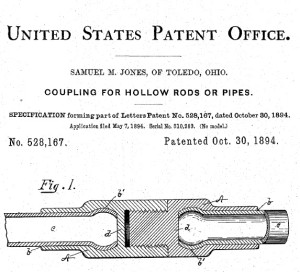
Samuel Jones had worked as a potboiler, pumper, tool dresser, blacksmith, and pipe layer.
Jones had worked in Pennsylvania’s oil region as a potboiler, pumper, tool dresser, blacksmith, and pipe layer. He became known as “Golden Rule” Jones by establishing a better workplace for employees at his factory, where he shortened the work day and started a revenue-sharing program.
Jones ran for Toledo mayor as a progressive Republican in 1887 and was elected. He was reelected three times and served until dying on the job in 1904.
Learn more in “Golden Rule” Jones of Ohio.

October 31, 1871 – Modern Refinery Method patented
Petroleum refining would become more efficient thanks to an invention by Henry Rogers of Brooklyn, New York, who patented an “apparatus for separating volatile hydrocarbons by repeated vaporization and condensation.”
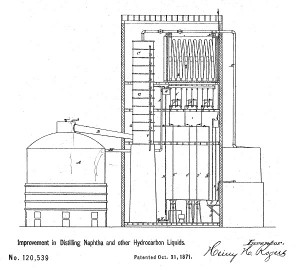
Henry Rogers improved the refining of kerosene.
Rogers introduced many elements of modern refineries, including “fractionating” towers that improved earlier processes of extracting kerosene by simple distillation in kettle stills.
“The apparatus which I use is, in many respects, similar to what is known as the column-still for distilling alcoholic spirits, but modified in all the details, so as to make it available for distilling oils,” Rogers noted in his 1871 patent application. More technological advancements would lead to giant refining operations like the Standard Oil of Indiana Whiting Refinery, which opened in 1889.
October 31, 1903 – Salt-Dome Oilfield discovered in Texas
One mile north of Batson, Texas, a discovery well drilled by W.L. Douglas’ Paraffine Oil Company produced 600 barrels of oil a day from a depth of 790 feet. A second well drilled two months later in the Batson field produced 4,000 barrels of oil a day from 1,000 feet deep. Many new ventures joined the drilling boom (see Buffalo Oil Company).
When combined with other newly discovered prolific salt-dome fields, Spindletop (1901), Sour Lake (1901), and at Humble (1905), “Batson helped to establish the basis of the Texas oil industry when these shallow fields gave up the first Texas Gulf Coast oil,” noted the Texas State Historical Association in 2010.

October 31, 1913 – First Paved U.S. Highway dedicated
Towns and cities nationwide celebrated the opening of the Lincoln Highway, the 3,389-mile-long “Main Street Across America” connecting Times Square in New York City to San Francisco’s Lincoln Park. The Lincoln Highway was the first national memorial dedicated to President Abraham Lincoln. In 1919, the Army Motor Transport Corps organized a transcontinental convoy to test vehicles and highlight the need for more paved roads.
October 31, 1924 – Former Olinda Oil Wells Pitcher plays Exhibition Game
Former oilfield worker Walter “Big Train” Johnson returned to his California oil patch roots for an exhibition game with Babe Ruth in Brea, California. Ruth swatted two home runs off the future Hall of Fame pitcher. Three decades earlier, Johnson had started his baseball career as a 16-year-old pitcher for the Olinda Oil Wells.
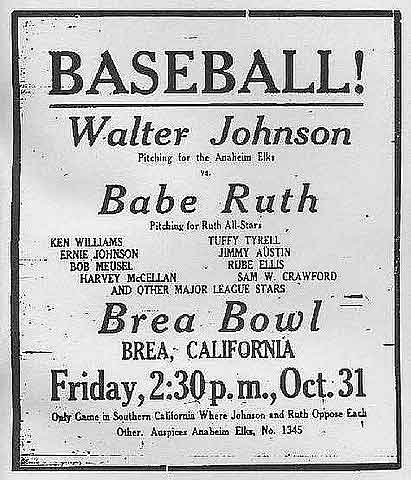
The former star player for the Olinda Oil Wells pitched against Babe Ruth in a 1924 exhibition game in nearby Brea.
Playing for the Washington Senators, the former roustabout became major league baseball’s all-time career leader in shutouts with 110. Many oilfield towns once fielded teams with names proudly reflecting their communities’ livelihood.
Learn more in Oilfields of Dreams – Gassers, Oilers, and Drillers Baseball Teams.
October 31, 1930 – Properties of Columbus “Dad” Joiner placed into Receivership
After it was learned 70-year-old wildcatter Columbus Marion “Dad” Joiner had oversold his East Texas oilfield leases in Rusk County, District Judge R.T. Brown placed the properties into receivership.
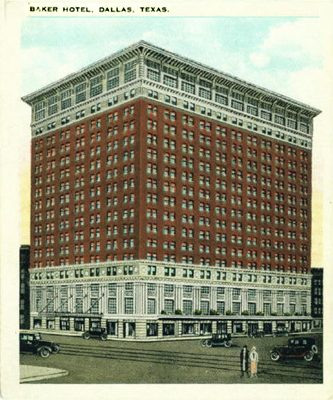
The Baker Hotel in Dallas was where Columbus “Dad” Joiner, discoverer of the East Texas oilfield, met with H.L. Hunt and sold Hunt 5,580 acres for $1.34 million. Built in 1925, the hotel was torn down in 1980.
With the field’s Daisy Bradford No. 3 and other wells tied up in conflicting claims, Joiner took refuge from creditors in the Baker Hotel in Dallas, where Haroldson Lafayette (H.L.) Hunt negotiated a $1.34 million deal with him for the discovery well and 5,580 acres of leases. In the 300 lawsuits and 10 years of litigation that followed, Hunt sustained every title.
November 1, 1865 – First Railroad Oil Tank Car arrives
The first of James and Amos Densmore’s innovative railroad oil tank cars arrived at the Miller Farm, four miles south of Titusville, Pennsylvania. The inventors would be awarded a U.S. patent on April 10, 1866, for their dual tank design.

Brothers Amos and James Densmore designed and built the first successful railroad tank cars used in the Pennsylvania oilfields in 1865. Photo courtesy Drake Well Museum.
The crude oil for the iron-banded wooden tanks on a flatcar was delivered by Samuel Van Syckle’s two-inch iron pipeline (another oil industry first) from the oilfield boom town at Pithole Creek. Oil from large storage tanks on the farm filled the Densmore tanks for the Oil Creek Railroad, which connected to lines reaching Pittsburgh, New York City, and other markets.
Learn more in Densmore Brothers Oil Tank Car.

November 2, 1902 – First Gas-Powered Locomobile delivered
Known for building luxury steam-powered automobiles, the Locomobile Company of America delivered its first gasoline-powered auto to a buyer in New York City. The company had hired Andrew Riker, a self-taught engineer and racecar driver, to create the four-cylinder, 12-horsepower vehicle, which sold for $4,000.

The four-cylinder gasoline engine of Locomobile “Old 16” racing car on display in the Henry Ford Museum, Dearborn, Michigan.
In 1908, a Locomobile “Old 16,” a four-cylinder, 16-liter, two-seater, won America’s first international racing victory — the Vanderbilt Cup at the Long Island Motor Parkway, one of the first paved parkways. The Locomobile Company would “reign supreme in the niche category of luxury American cars for decades,” according to Today in Connecticut History.
November 3, 1878 – Haymaker Natural Gas Well lights Pittsburgh
While drilling for oil in 1878, a well drilled by Michael and Obediah Haymaker erupted with natural gas from a depth of almost 1,400 feet. “Every piece of rigging went sky high, whirling around like so much paper caught in a gust of wind. But instead of oil, we had struck gas,” Michael Haymaker recalled.
Eighteen miles east of Pittsburgh, the out-of-control well in Murrysville, Pennsylvania, produced an estimated 34 million cubic feet of natural gas daily. It was considered the largest natural gas well ever drilled up to that time.
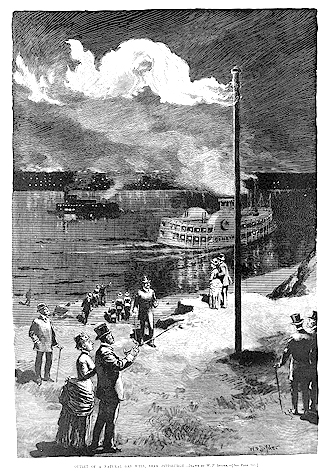
“A sight that can be seen in no other city in the world,” noted Harper’s Weekly in 1885.
Given oilfield technologies of the late 1880s, there was no way to cap the well and no pipeline to exploit commercial possibilities. The Haymaker well drew thousands of curious onlookers to a flaming torch that burned for 18 months and was visible miles away.
“Outlet of a natural gas well near Pittsburgh — a sight that can be seen in no other city in the world,” noted Harper’s Weekly. When finally brought under control, the Haymaker well provided inexpensive gas light to Pittsburgh for many years.
Learn more in Natural Gas is King in Pittsburgh.

November 3, 1900 – New York City hosts First U.S. Auto Show
America’s first gathering of the latest automotive technologies attracted thousands to New York City’s Madison Square Garden. Manufacturers presented 160 different vehicles and conducted driving and maneuverability demonstrations on a 20-foot-wide wooden track that encircled the exhibits.
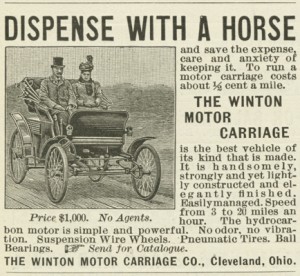
The Winton Motor Carriage of 1898 was the first American automobile advertisement.
Almost 50,000 visitors paid 50 cents each to witness autos driving up a 200-foot ramp to test hill-climbing power. The most popular models proved to be electric, steam, and gasoline…in that order. New Yorkers welcomed the new models as a way to reduce the 450,000 tons of manure and 15,000 horse carcasses that had to be removed from city streets every year.
Of the 4,200 automobiles sold in 1900, less than a thousand were powered by gasoline. But within five years, consumer preference established the dominance of gasoline-powered autos.
Learn more in Cantankerous Combustion — 1st U.S. Auto Show and First Gas Pump and Service Station.
_______________________
Recommended Reading: Holy Toledo: Religion and Politics in the Life of “Golden Rule” Jones (1998); The Bradford Oil Refinery, Pennsylvania, Images of America
(1998); The Bradford Oil Refinery, Pennsylvania, Images of America (2006); Early Texas Oil: A Photographic History, 1866-1936
(2006); Early Texas Oil: A Photographic History, 1866-1936 (2000); The Lincoln Highway: Coast to Coast from Times Square to the Golden Gate
(2000); The Lincoln Highway: Coast to Coast from Times Square to the Golden Gate (2011); Oil on the Brain: Petroleum’s Long, Strange Trip to Your Tank
(2011); Oil on the Brain: Petroleum’s Long, Strange Trip to Your Tank (2008); The Extraction State, A History of Natural Gas in America(2021); A History of the New York International Auto Show: 1900-2000
(2008); The Extraction State, A History of Natural Gas in America(2021); A History of the New York International Auto Show: 1900-2000 (2000). Your Amazon purchase benefits the American Oil & Gas Historical Society. As an Amazon Associate, AOGHS earns a commission from qualifying purchases.
(2000). Your Amazon purchase benefits the American Oil & Gas Historical Society. As an Amazon Associate, AOGHS earns a commission from qualifying purchases.
_______________________
The American Oil & Gas Historical Society (AOGHS) preserves U.S. petroleum history. Become an AOGHS annual supporting member and help maintain this energy education website and expand historical research. For more information, contact bawells@aoghs.org. Copyright © 2023 Bruce A. Wells. All rights reserved.
.
by Bruce Wells | Oct 23, 2023 | This Week in Petroleum History
October 23, 1908 – Salt Creek Well launches Wyoming Boom –
Wyoming’s first oil boom began when the Dutch company Petroleum Maatschappij Salt Creek completed its “Big Dutch” well about 40 miles north of Casper. Salt Creek’s potential had been known since the 1880s, but the area’s central geological salt dome received little attention until Italian geologist Cesare Porro recommended drilling there in 1906.
Five years earlier, a salt dome formation had revealed the giant Spindletop oilfield in Texas.
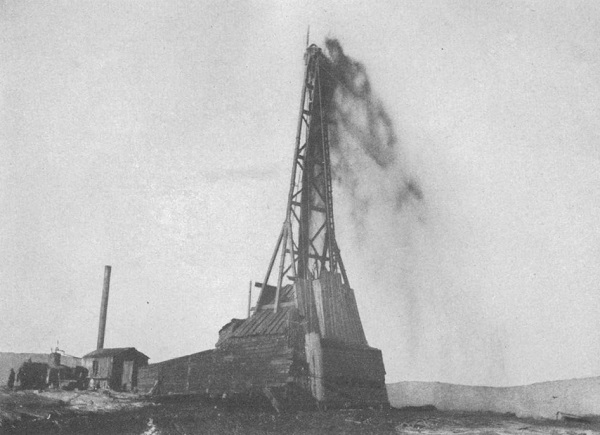
The “Big Dutch” No. 1 well, above, launched a Wyoming drilling boom in 1908. Photo courtesy U.S. Geological Survey.
The Oil Wells Drilling Syndicate, a British company, drilled the “Big Dutch” well, which produced 600 barrels of oil a day from 1,050 feet deep. By 1930, about one-fifth of all U.S. oil production came from the Salt Creek oilfield. Production continued with water-flooding technologies in the 1960s and the use of carbon dioxide injection beginning in 2004.
Learn more in First Wyoming Oil Wells.

October 23, 1948 – “Smart Pig” advances Pipeline Inspection
Northern Natural Gas Company recorded the first use of an X-ray machine for internal testing of petroleum pipeline welds. The company examined a 20-inch diameter pipe north of its Clifton, Kansas, compressor station. The device — today known as a “smart pig” — traveled up to 1,800 feet inside the pipe, imaging each weld.
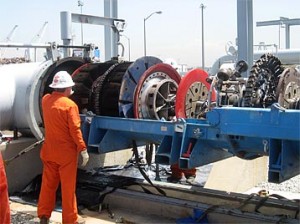
A pipeline worker inspects a “smart pig.” Photo courtesy Pacific L.A. Marine Terminal.
As early as 1926, U.S. Navy researchers had investigated the use of gamma-ray radiation to detect flaws in welded steel. In 1944, Cormack Boucher patented a “radiographic apparatus” suitable for large pipelines. Modern inspection tools employ magnetic particle, ultrasonic, eddy current, and other methods to verify pipeline and weld integrity.
October 23, 1970 – LNG powers World Land Speed Record
Liquefied natural gas (LNG) powered the Blue Flame to a new world land speed record of 630.388 miles per hour. A rocket motor combining LNG and hydrogen peroxide fueled the 38-foot, 4,950-pound Blue Flame, which set the record at the Bonneville Salt Flats in Utah. The rocket motor could produce up to 22,000 pounds of thrust — about 58,000 horsepower.

In 1970, the Blue Flame achieved, “the greenest world land speed record set in the 20th century.”
Sponsored by the American Gas Association (AGA) and the Institute of Gas Technology, the Blue Flame design came from three Milwaukee, Wisconsin, automotive engineers: Dick Keller, Ray Dausman, and Pete Farnsworth. After building a record-setting rocket dragster in 1967 that got the attention of AGA executives, the men began designing a more ambitious vehicle.

The American Oil & Gas Historical Society interviewed Dick Keller in 2013 to produce a YouTube video using his 8mm home movies.
Interviewed for a 2013 video featuring his home movies, Keller explained how the growing environmental movement of the late 1960s, encouraged AGA “suits” to see value in educating consumers about natural gas as a fuel. In 2020. he published Speedquest: Inside the Blue Flam, his account of the last U.S. team to set the world land speed record. The Blue Flame, fueled by natural gas, remains “the greenest world land speed record set in the 20th century,” according to Keller,
Learn more in Blue Flame Natural Gas Rocket Car.

October 25, 1929 – Cabinet Member guilty in Teapot Dome Scandal
Albert B. Fall, appointed Interior Secretary in 1921 by President Warren G. Harding, was found guilty of accepting a bribe while in office, becoming the first cabinet official in U.S. history to be convicted of a felony. An executive order from President Harding had given Fall full control of the Naval Petroleum Reserves.
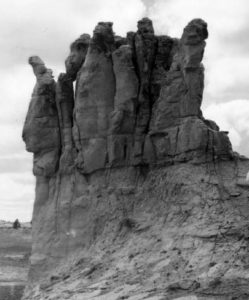
Wyoming’s Teapot Dome oilfield was named after Teapot Rock, seen here circa 1922 (the “spout” later fell off). Photo courtesy Casper College Western History Center.
Fall was found guilty of secretly leasing the Navy’s oil reserve lands to Harry Sinclair of Sinclair Oil Company and to Edward Doheny, discoverer of the Los Angeles oilfield.
The noncompetitive leases were awarded to Doheny’s Pan American Petroleum Company (reserves at Elk Hills and Buena Vista Hills, California), and Sinclair’s Mammoth Oil Company (reserve at Teapot Dome, Wyoming). Fall received more than $400,000 from the two oil companies.
It emerged during In Senate hearings that cash was delivered to Secretary Fall in a Washington, D.C., hotel. He was convicted of taking a bribe, fined $100,000, and sentenced to one year in prison. Sinclair and Doheny were acquitted, but Sinclair spent six-and-a-half months in prison for contempt of court and the U.S. Senate.
October 26, 1970 – Joe Roughneck Statue dedicated in Texas
Texas Governor Preston Smith dedicated a “Joe Roughneck” memorial in Boonsville to mark the 20th anniversary of a giant natural gas field discovery there. In 1950, the Lone Star Gas Company Vaught No. 1 well had discovered the Boonsville field, which produced 2.5 billion cubic feet of natural gas over the next 20 years.
By 2001 the Boonsville field in East Texas reached production of 3.1 trillion cubic feet of gas from more than 3,500 wells.
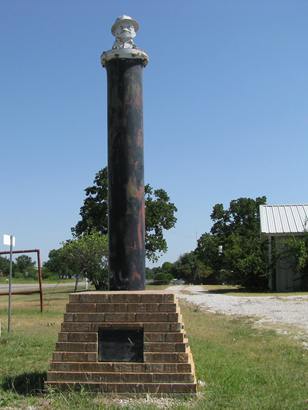
“Joe Roughneck” in Boonsville, Texas. Photo, courtesy Mike Price.
“Joe Roughneck” began as a character in Lone Star Steel Company advertising in the 1950s. A bronze bust was awarded each year (until 2020) at the Chief Roughneck Award ceremony of the Independent Petroleum Association of America (IPAA). In addition to the Boonsville monument, Joe’s bust sits atop three different Texas oilfield monuments: Joinerville (1957), Conroe (1957) and Kilgore (1986).
Learn more in Meet Joe Roughneck.

October 27, 1763 – Birth of Pioneer American Geologist
William Maclure, who would become a renowned American geologist and “stratigrapher,” was born in Ayr, Scotland. He created the earliest geological maps of North America in 1809 and later earned the title, “Father of American Geology.”
After settling in the United States in 1797, Maclure explored the eastern part of North America to prepare the first geological map of the United States. His travels from Maine to Georgia in 1808 resulted in the first geological map of the new United States.
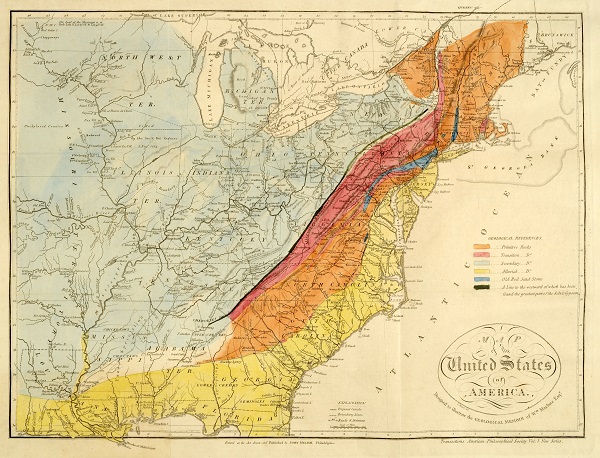
“Map of the United States of America, Designed to Illustrate the Geological Memoir of Wm. Maclure, Esqr.” This 1818 version is more detailed than the first geological map he published in 1809. Image courtesy the Historic Maps Collection, Princeton Library.
“Here, in broad strokes, he identifies six different geological classes,” a Princeton geologist reported. “Note that the chain of the Appalachian Mountains is correctly labeled as containing the most primitive, or oldest, rock.”
In the 1850s, a chemist at Yale analyzed samples of Pennsylvania “rock oil” for refining into kerosene; his report led to the drilling of the first U.S. oil well in 1859 (also see Rocky Beginnings of Petroleum Geology).
October 27, 1923 – Refining Company founded in Arkansas
Lion Oil Company was founded as a refining Company in El Dorado, Arkansas, by Texan Thomas Harry Barton. He earlier had organized the El Dorado Natural Gas Company and acquired a 2,000-barrel-a-day refinery in 1922.

Founded in 1923 in El Dorado, Arkansas, Lion Oil will operate about 2,000 service stations in the south in the 1950s. Photo courtesy Lion Oil.
Production from the nearby Smackover oilfield helped the Lion Oil Refining Company’s refining capacity grow to 10,000 barrels a day. By 1925, the company acquired oil wells producing 1.4 million barrels of oil.
A merger with Monsanto Chemical in 1955 brought the gradual disappearance of the once familiar “Beauregard Lion” logo. The company has continued to sell a variety of petroleum products, including gasoline, low-sulfur diesel fuel, solvents, propane and asphalt.
Learn more Arkansas history in Arkansas Oil and Gas Boom Towns.
October 28, 1926 – Yates Field discovered West of the Pecos in Texas
The 26,400-acre Yates oilfield was discovered in a remote area of Pecos County, Texas, in the Permian Basin. Drilled in 1926 with a $15,000 cable-tool rig, the Ira Yates 1-A produced 450 barrels of oil a day from almost 1,000 feet deep. Prior to the giant oilfield discovery, Ira Yates had struggled to keep his ranch on the northern border of the Chihuahua Desert.
“Drought and predators nearly did him in” noted one historian, until Yates convinced a San Angelo company to explore for oil west of the Pecos River. With the Pecos County well 30 miles from the nearest oil pipeline and a storage tank under construction, four more Yates wells yielded another 12,000 barrels of oil a day.
Ira Yates would receive an $18 million oil royalty check on his 67th birthday. Also see Santa Rita taps Permian Basin.

October 27, 1938 – DuPont names Petroleum Product “Nylon”
DuPont chemical company announced that “Nylon” would be the name of its newly invented synthetic fiber yarn made from petroleum. Discovered in 1935 by Wallace Carothers at a DuPont research facility, nylon is considered the first commercially successful synthetic polymer.
Nylon found widespread applications in consumer products, including toothbrushes, fishing lines, luggage and lingerie, or in special uses like surgical thread, parachutes, and pipes. Carothers would become known as the father of the science of man-made polymers (see Nylon, a Petroleum Polymer).
October 28, 1868 – Newspaper praises Explosive Technology
In Pennsylvania, the Titusville Morning Herald praised results of an explosive oilfield production technology, Civil War veteran Colonel E.A.L. Roberts’ patented nitroglycerin torpedo. “It would be superfluous, at this late day, to speak of the merits of the Roberts Torpedo,” the 1868 newspaper article explained.
“For the past three years, it has been a most successful operation, and has increased the production of oil in hundreds upon hundreds of oil wells to an extent which could hardly be overestimated” (see Shooters – a “Fracking” History).
_______________________
Recommended Reading: The Salt Creek Oil Field: Natrona County, Wyoming, 1912 (2017); Oil and Gas Pipeline Fundamentals
(2017); Oil and Gas Pipeline Fundamentals (1993); The Reluctant Rocketman: A Curious Journey in World Record Breaking
(1993); The Reluctant Rocketman: A Curious Journey in World Record Breaking (2013); Speedquest: Inside the Blue Flame (2020); The Bradford Oil Refinery, Pennsylvania, Images of America
(2013); Speedquest: Inside the Blue Flame (2020); The Bradford Oil Refinery, Pennsylvania, Images of America (2006); Early Louisiana and Arkansas Oil: A Photographic History, 1901-1946
(2006); Early Louisiana and Arkansas Oil: A Photographic History, 1901-1946 (1982); Du Pont Dynasty: Behind the Nylon Curtain
(1982); Du Pont Dynasty: Behind the Nylon Curtain (1984); The Boom: How Fracking Ignited the American Energy Revolution and Changed the World
(1984); The Boom: How Fracking Ignited the American Energy Revolution and Changed the World (2015); Your Amazon purchase benefits the American Oil & Gas Historical Society. As an Amazon Associate, AOGHS earns a commission from qualifying purchases.
(2015); Your Amazon purchase benefits the American Oil & Gas Historical Society. As an Amazon Associate, AOGHS earns a commission from qualifying purchases.
_______________________
The American Oil & Gas Historical Society (AOGHS) preserves U.S. petroleum history. Become an AOGHS annual supporting member and help maintain this energy education website and expand historical research. For more information, contact bawells@aoghs.org. Copyright © 2023 Bruce A. Wells. All rights reserved.
by Bruce Wells | Oct 16, 2023 | This Week in Petroleum History
October 16, 1931 – Natural Gas Pipeline sets Record –
The first long-distance, high-pressure U.S. natural gas pipeline went into service during the Great Depression, linking prolific Texas Panhandle gas fields to consumers in Chicago.
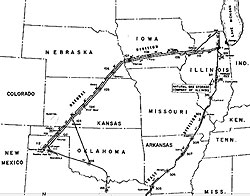
A 1931 natural gas pipeline extended 980 miles from North Texas to Illinois.
A.O. Smith Corporation developed the technology for a thin-walled pipe, and Continental Construction Corporation built the 980-mile bolted flange pipeline for the Natural Gas Pipeline Company of America (NGPL).
The $75 million high-tech pipeline project consumed 209,000 tons of specially fabricated 24-inch wide steel pipe, which filled 6,500 freight cars. The project required 2,600 separate right-of-way leases (also see Big Inch Pipelines of WWII).

October 17, 1890 – Union Oil of California founded
Lyman Stewart, Thomas Bard and Wallace Hardison founded the Union Oil Company of California by merging their petroleum properties to compete with Standard Oil of California (founded 20 years earlier). Union Oil made strategic alliances with small oil producers to build pipelines from Kern County oilfields to the Pacific coast.
“This gave the independent producers an alternative to what they perceived as the low prices paid by Standard Oil and the high freight rates charged by the railroads to move crude oil,” noted the American Institute of Mining in 1914. Union Oil moved the company headquarters from Santa Paula to Los Angeles in 1901.
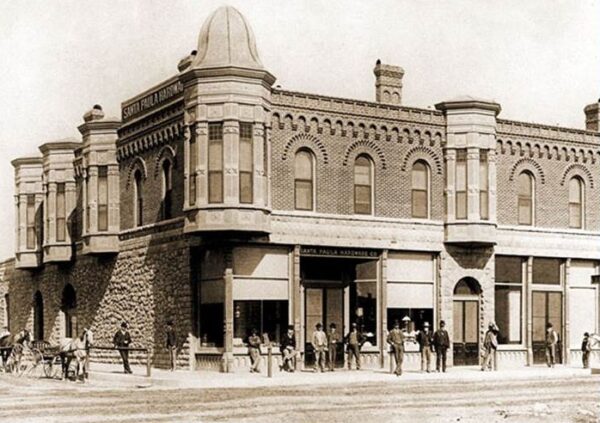
After becoming the Union Oil Museum in 1950, the company’s Santa Paula headquarters building in 1990 was restored to its original appearance and reopened as the California Oil Museum.
In 1910, Union Oil lost control of its Midway-Sunset field’s Lakeview No. 1 well, which would take 18 months to control. The purchase of Pennsylvania-based Pure Oil in 1965 made the Unocal Union 76 brand a nationwide company.
In 2005, Unocal became a subsidiary of Chevron. The Santa Paula company headquarters building, a California Historical Landmark, in 1990 became home to the California Oil Museum.
October 17, 1917 – “Roaring Ranger” launches Major Texas Drilling Boom
A wildcat well between Abilene and Dallas launched a Texas drilling boom that helped fuel the Allied victory in World War I. The J.H. McCleskey No. 1 well erupted oil about two miles south of the small town of Ranger, which had been founded in the 1870s near a Texas Ranger camp in Eastland County.

The 1917 McCleskey No. 1 oil gusher in Texas made headlines as the “Roaring Ranger” that helped win World War I.
Texas and Pacific Coal Company’s William Knox Gordon completed the discovery well at a depth of 3,432 feet. It initially produced 1,600 barrels a day of quality, high gravity oil. Within 20 months the exploration company’s stock value jumped from $30 a share to $1,250 a share.
“Roaring Ranger” launched a drilling boom that extended to nearby towns. More gushers followed, some producing up to 10,000 barrels of oil every day, and Ranger’s population grew from 1,000 to 30,000.

Eastland County discoveries included oil wells near Cisco, where Conrad Hilton bought his first hotel.
The petroleum proved essential in World War I. After the armistice was signed in 1918, a member of the British War Cabinet declared, “The Allied cause floated to victory upon a wave of oil.”
After the war, a veteran named Conrad Hilton visited Eastland County intending to buy a bank. When his deal fell through, Hilton — at the Cisco train station ready to leave — noticed a small hotel with a line of roughnecks waiting for a room (see Oil Boom Brings First Hilton Hotel).

October 17, 1973 – Embargo bring Gas Lines, Recession
Fifty years ago, the Organization of Petroleum Exporting Countries (OPEC) implemented what it called “oil diplomacy,” prohibiting any nation that had supported Israel in the Yom Kippur War from buying the cartel’s oil. The embargo brought an end to years of cheap gasoline and caused the New York Stock Exchange to drop by almost $100 billion. It also created one of the worst recessions in U.S. history. The United States became the world’s top petroleum producer in 2017, surpassing Russia and Saudi Arabia.
October 18, 2008 – Derrick dedicated in Discovery 1 Park
A re-enactment of the dramatic moment that changed Oklahoma history highlighted the 2008 dedication of a 84-foot replica derrick at Discovery 1 Park in Bartlesville, Oklahoma. Events included roughneck reenactors and a water gusher from an 84-foot derrick that replaced one dedicated in 1948.
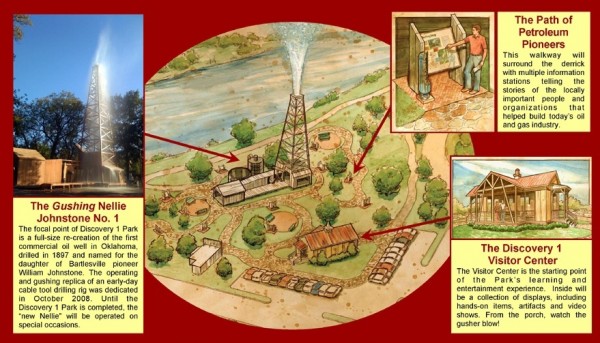
Discovery 1 Park in Bartlesville includes a replica derrick on the original site of Oklahoma’s first oil well.
In 1897, a cable-tool drilling rig at the site of Oklahoma’s first commercial oil well had thrilled another group of spectators when Jenny Cass, stepdaughter of Bartlesville founder George W. Keeler, was given the honor of “shooting” the well.
Today, the Bartlesville Community Foundation plans on adding a visitors center to Discovery 1 Park.
October 19, 1990 – First Emergency Use of Strategic Petroleum Reserve
As world oil prices spiked after the August 1990 invasion of Kuwait by Saddam Hussein’s Iraqi troops, the first presidentially mandated emergency use of the Strategic Petroleum Reserve was authorized by George H. W. Bush, who ordered sale of five million barrels of SPR oil as a test to “demonstrate the readiness of the system under real life conditions,” according to the Department of Energy.

The Strategic Petroleum Reserve’s four oil storage facilities are grouped into three geographical pipeline distribution systems
in Texas and Louisiana. Map courtesy U.S. Department of Energy, Report to Congress, December 2018.
President Ford established the SPR in 1975 as a protection against severe supply interruptions. By 2020, four underground salt dome sites along the Gulf Coast stored 735 million barrels of oil — the largest stockpile of government-owned emergency oil in the world.
October 20, 1944 – Liquefied Natural Gas Tank explosion in Ohio
An explosion and fire from liquefied natural gas tanks in Cleveland, Ohio, killed 131 people and caused more than $10 million in damage. Temperatures inside of one of the East Ohio Gas Company’s tanks reportedly had been allowed to fall below minus 250 degrees, which caused the steel plates to contract and rupture. Investigators never discovered a cause for the explosion, but witnesses reported a leak in one of the tanks, according to Ohio History Central. “Some spark must have then ignited the gas, although, with World War II currently raging, some residents initially suspected a German saboteur.”

October 20, 1949 – Maryland produces Some Natural Gas
The first commercially successful natural gas well in Maryland was drilled by the Cumberland Allegheny Gas Company in the town of Mountain Lake Park, Garrett County — the westernmost county in the state. The Elmer Beachy well produced about 500 thousand cubic feet of natural gas a day.

No oil has been produced in Maryland.
The discovery well prompted a rush of competing companies and high-density drilling (an average of nine wells per acre), which depleted the field. Twenty of 29 wells drilled within the town produced natural gas, but overall production from the field was low. No oil has been found in Maryland.
October 21, 1921 – First Natural Gas Well in New Mexico
New Mexico’s natural gas industry began when the newly formed Aztec Oil Syndicate’s State No. 1 well found gas reserves about 15 miles northeast of Farmington in San Juan County.
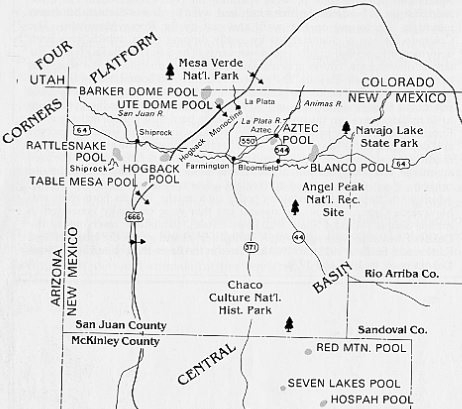
New Mexico’s first commercial natural gas service began after a 1921 discovery near Aztec. Oil discoveries followed in the southeast.
The drilling crew used a trimmed tree trunk with a two-inch pipe and shut-off valve to control the well until a wellhead was shipped in from Colorado. The well produced 10 million cubic feet of natural gas a day.
By the end of December 1921, a pipeline reached two miles into the town of Aztec, where citizens enjoyed New Mexico’s first commercial natural gas service. In 1922, natural gas could be purchased in Aztec at a flat rate of $2 a month (for a gas heater) and $2.25 (for a gas stove).
Learn more about the state’s petroleum history in New First Mexico Oil Wells.
_______________________
Recommended Reading: Oil and Gas Pipeline Fundamentals (1993); The 76 bonanza: The fabulous life and times of the Union Oil Company of California
(1993); The 76 bonanza: The fabulous life and times of the Union Oil Company of California (1966); Ranger, Images of America
(1966); Ranger, Images of America (2010); Desert Kingdoms to Global Powers: The Rise of the Arab Gulf
(2010); Desert Kingdoms to Global Powers: The Rise of the Arab Gulf (2016); Bartlesville, Oklahoma, Postcard History Series
(2016); Bartlesville, Oklahoma, Postcard History Series  (2000); Oil in West Texas and New Mexico
(2000); Oil in West Texas and New Mexico (1982). Your Amazon purchase benefits the American Oil & Gas Historical Society. As an Amazon Associate, AOGHS earns a commission from qualifying purchases.
(1982). Your Amazon purchase benefits the American Oil & Gas Historical Society. As an Amazon Associate, AOGHS earns a commission from qualifying purchases.
_______________________
The American Oil & Gas Historical Society (AOGHS) preserves U.S. petroleum history. Become an AOGHS annual supporting member and help maintain this energy education website and expand historical research. For more information, contact bawells@aoghs.org. Copyright © 2023 Bruce A. Wells. All rights reserved.
by Bruce Wells | Oct 9, 2023 | This Week in Petroleum History
October 9, 1999 – Converted Offshore Platform launches Rocket –
Sea Launch, a Boeing-led consortium of companies from the United States, Russia, Ukraine and Norway, launched its first commercial rocket using the Ocean Odyssey, a modified semi-submersible drilling platform. After a demonstration flight in March, a Russian Zenit-3SL rocket carried a DirecTV satellite to geostationary orbit.
In 1988, the former drilling platform had been used by Atlantic Richfield Company (ARCO) for North Sea explorations. The Ocean Odyssey made 36 more rocket launches until 2014, when the consortium ended after Russia illegally annexed Ukraine’s Crimean peninsula.
Learn more in Offshore Rocket Launcher. (more…)


























